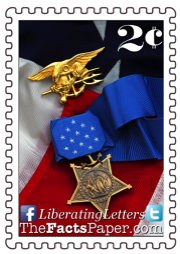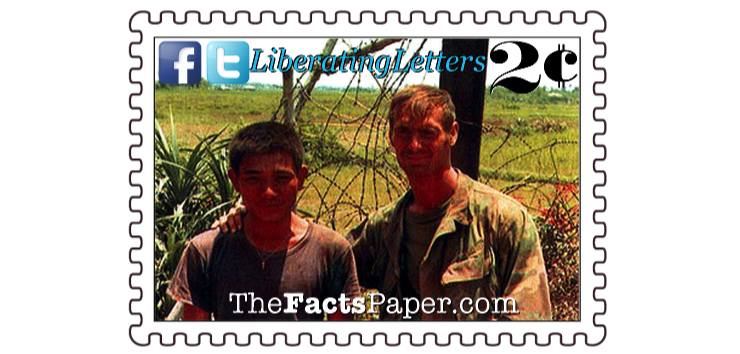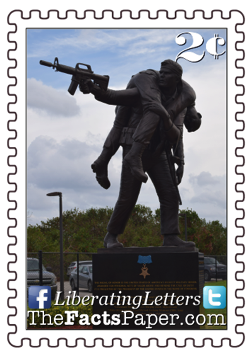The men were further honored on November 9, 2013, at the National Navy UDT-SEAL Museum in Fort Pierce, Florida. As visitors enter the grounds, they are now greeted by a 10-foot bronze statue, commissioned by former presidential candidate H. Ross Perot, portraying Thornton carrying Norris as he fires at the enemy. During the dedication, museum executive director Rick Kaiser stated, “It was the only time this century when one Medal of Honor winner was rescued by a person who would eventually get a Medal of Honor for rescuing him.”
Liberty, heroes are those that stand up to insurmountable odds and take on the challenge without backing down. We honor them for their courage and we hope that in similar times we will find the fortitude to stand with them when others run in fear. Heroes are those that look at what they did and simple say, “I was just doing my job.” And they will risk all they have so no one is left behind.
In a sense, Liberty, we are the most important heroes of all. As Christians, we are given the same directive as the SEALS from our commander. God wants ALL of His children to enjoy paradise and as His soldiers in the battlefield here on earth, our objective is to spread the Good News of Jesus Christ. He doesn’t want anyone left behind. Therefore, we should always focus on sharing the Gospel with as many souls as possible, even making personal sacrifices for the sake and love of others as a witness of God’s love. With God as our pilot, we can move mountains.
Liberty, be a hero.
That’s my 2 cents.
Love,
Mom
October 31, 2019
Dear Liberty,
Bullets flew by Michael’s head. He could hear the supersonic crack as the tracer rounds narrowly missed his massive frame. Today was going to be no easy day. He turned to see one of his Vietnamese companions approaching at a full run yelling, "Go, go!" Michael shouted back, "Where's my lieutenant?" He received the worst possible answer: "Dead". Without a second thought, Michael immediately turned back into the firefight to the protests of the three crewmen with him. "Let's go!" they urged.
"Not without my lieutenant!"
Thomas Norris, Michael Thornton and three of their South Vietnamese SEAL counterparts, called LDNNs or "frog men," climbed into a raft around 4 am on October 31, 1972, for an intelligence gathering mission. They quietly paddled the mile to shore, which was meant to be a simple recon behind enemy lines. Upon reaching the beach, they hid their raft before setting out for their destination. Walking for hours in the brush, they could not understand why they had not reached the river they were looking for. Believing they were lost, Norris radioed for location help only to discover they were much farther north than they targeted, putting them deep within enemy territory. Silently, Norris motioned for the group to return to the shore. Seconds from reaching the water, two enemy soldiers spotted the crew and fired upon the group. Within moments, fifty more AK-47s were unleashing 7.62 rounds at the SEALS.
Despite being grossly outnumbered, Norris, Thornton, and their companions administered massive damage to the enemy in their 45 minute battle. Running low on ammo, Lieutenant Norris radioed for cover fire only to learn the U.S.S. Newport News refused to fire upon the North Vietnamese Army (NVA) as Norris and his men were too close to the enemy. Willing to sacrifice himself for his team, Norris told the U.S.S. Newport News, "Give me 5 minutes then start firing." Ordering Thornton and two of the LDNNs to head to their hidden raft, he and the third LDNN gave them cover.
Unfortunately, a bullet found Norris.
Believing Norris was dead, the remaining LDNN headed towards the beach to escape with the others. However, Thornton wasn't going anywhere without his lieutenant.
Spotting Norris in the distance, Thornton defied odds and dodged bullets as he raced to the lifeless body. He and two enemy soldiers reached the body simultaneously. In one swift move, he eliminated both soldiers before discovering Norris was shot in the eye, exposing a section of his skull. Despite suffering from his own shrapnel wounds in both his legs and lower back, Thornton tossed Norris on his shoulder without a concern for himself.
Moments later, both were back on the ground, thrown down by explosives going off around them. Thornton regained his legs beneath him and headed towards the shore, slinging his lieutenant on his shoulder.
A SEAL through and through, Thornton knew he had to reach the water. There he would have the tactical advantage over the enemy, something engrained in him since Hell Week during his selection process to the SEAL teams. Michael bolted across the open 400 yard beach, holding his wounded lieutenant with one arm and returning fire with the other. Upon reaching the shoreline he discovered another from his party had been wounded. Inflating all three of their life vests, he pulled the men out into the water, praying someone would come to get them.
Bullets pierced the water as Thornton swam out to sea with the other frog men, holding his lieutenant and the wounded Vietnamese SEAL. Once out of range of the enemy, he held tight to the men and prayed for a miracle. After what seemed like eternity, Thornton spotted a ship. He held his breath as it got closer. An answer to a prayer, it was the same South Vietnamese Navy vessel that had dropped them off hours earlier. Despite wading in the water for two hours with undressed wounds, Thornton, Norris, and the others survived their brush with death.
That was the second brush with death Lieutenant Norris survived that year.
In April 1972, Lt. Norris was the critical player in the most dramatic rescue of the Vietnam War. Lieutenant Mark Clark and Lieutenant Colonel Iceal Hambleton were shot down well behind enemy lines. NVA and Viet Cong soldiers were hunting for the two crewmen, who had little to look forward to beyond torture at the Hanoi Hilton. Both men hid deep in enemy territory in Quang Tri Province as they radioed for help and hoped for rescue.
Norris volunteered to lead a team to locate the downed fliers. In charge of another small rescue group, he and his 5-man South Vietnamese "frog men" crew set out to find the two downed airmen on April 10, 1972.
In the thick jungle, Norris separated from the others, keeping contact by radio. Locating Lieutenant Clark concealing himself along the river's edge, the two men remained along the shore line as a North Vietnamese patrol marched by. When the threat passed, Norris slipped into the brisk water to retrieve Clark, but the airman had disappeared, carried away by the current. Norris maneuvered through the fast moving water searching for Clark. As dawn broke, he spotted Clark again through the morning light. He made it to the airman. Nail-38 Bravo had been rescued.
Reuniting with the other members of his team, the group returned to the Forward Operating Base (FOB). Hours later, North Vietnamese rockets rained down on the small base, inflicting massive casualties and forcing an emergency evacuation the next morning.
Undeterred by the assault, Norris planned to find the second downed aviator, BAT-21 Bravo, despite two of his three surviving Vietnamese guides refusing to accompany him. Receiving word that an air controller located the missing pilot, Petty Officer Nguyen Van Kiet agreed to continue on with Norris. The two men (shown below) disguised themselves as local fisherman and headed out. Coming upon a deserted camp along the river, they discovered a sampan, or small boat, which they placed in the water to complete their masquerade.
NO ONE LEFT BEHIND

Blending with the darkness and moving swiftly with the current, they found Lt. Col. Hambleton as the sun started to rise on the morning of April 13. Camouflaging him in the bottom of their boat, the men began paddling towards their base. They glided past a NVA patrol without drawing suspicion, only to catch the attention of soldiers stationed in a bunker on the river’s edge. They began showering the small boat with heavy machine gun fire. Despite the attack, Norris rescued BAT-21 from one of the largest manhunts of the war.
Seven months later, Norris found himself in need of rescuing.
Doctors were not optimistic regarding Norris' chance at survival after the attack that took his eye. He was weak and lucky to be alive when he heard that Thornton would be awarded the Congressional Medal of Honor for his heroic actions in saving his life. Despite his condition, Norris immediately requested permission from his doctors at Bethesda Naval Hospital to attend the ceremony. To his dismay, he was denied.
Thornton took that as a challenge. He didn’t leave his lieutenant in Vietnam. He certainly wasn’t going to leave him in the hospital. ”We had to kidnap him, right out of Bethesda. But he was there!" Thornton's heroic actions were the last in the Vietnam War to be awarded the Medal of Honor.
The 1988 film BAT-21 is based on Hambleton's rescue, presenting the heroic event from the aviator’s point of view. As is typical with Hollywood, many facts were changed and eliminated in the process of telling the story. The fiction didn’t live up to the truth as much of the operation had to remain hidden. The classified operation remained secret and Norris' role in the dynamic rescue was kept from the movie and the book that inspired it. As a result, Norris' truly heroic actions were unknown to the public for decades.
Norris didn't mind. He was merely doing his job. Norris even rejected his submission for the Medal of Honor. Despite his misgivings, the paperwork went through and Norris received his own Medal of Honor on March 4, 1976, with Thornton proudly watching on.
Thornton's distinguished Navy career continued until after Operation Desert Storm in 1991. Today he is living out his retirement in Houston, Texas. Despite Norris' massive injury, he passed the FBI exam, becoming an agent and fulfilling a childhood dream. He retired from an impressive tenure in the agency as part of the hostage rescue unit, and now resides in Idaho.




